2006 SUBARU TRIBECA overheating
[x] Cancel search: overheatingPage 5 of 377
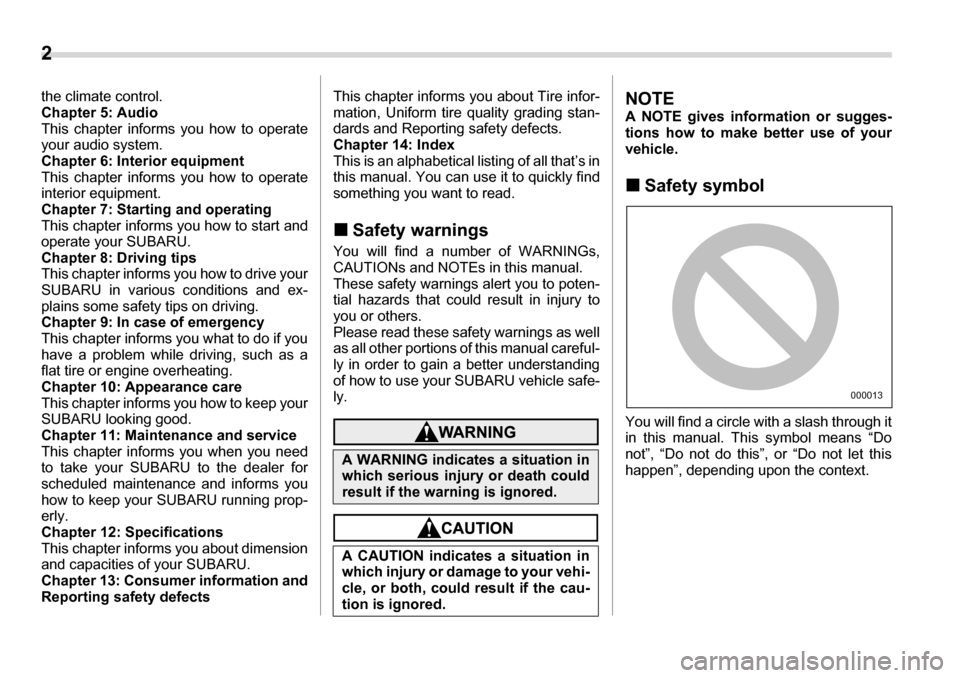
2
the climate control.
Chapter 5: Audio
This chapter informs you how to operate
your audio system.
Chapter 6: Interior equipment
This chapter informs you how to operate
interior equipment.
Chapter 7: Starting and operating
This chapter informs you how to start and
operate your SUBARU.
Chapter 8: Driving tips
This chapter informs you how to drive your
SUBARU in various conditions and ex-
plains some safety tips on driving.
Chapter 9: In case of emergency
This chapter informs you what to do if you
have a problem while driving, such as a
flat tire or engine overheating.
Chapter 10: Appearance care
This chapter informs you how to keep your
SUBARU looking good.
Chapter 11: Maintenance and service
This chapter informs you when you need
to take your SUBARU to the dealer for
scheduled maintenance and informs you
how to keep your SUBARU running prop- erly.
Chapter 12: Specifications
This chapter informs you about dimension
and capacities of your SUBARU.
Chapter 13: Consumer information and
Reporting safety defects This chapter informs you about Tire infor-
mation, Uniform tire quality grading stan-
dards and Reporting safety defects.
Chapter 14: Index
This is an alphabetical listing of all that’s in
this manual. You can use it to quickly find
something you want to read. �„
Safety warnings
You will find a number of WARNINGs,
CAUTIONs and NOTEs in this manual.
These safety warnings alert you to poten-
tial hazards that could result in injury to you or others.
Please read these safety warnings as well
as all other portions of this manual careful-
ly in order to gain a better understanding of how to use your SUBARU vehicle safe- ly.NOTE
A NOTE gives information or sugges-
tions how to make better use of your
vehicle. �„ Safety symbol
You will find a circle with a slash through it
in this manual. This symbol means “Do
not”, “Do not do this”, or “Do not let this
happen”, depending upon the context.
A WARNING indicates a situation in
which serious injury or death could
result if the warning is ignored.
A CAUTION indicates a situation in
which injury or damage to your vehi-
cle, or both, could result if the cau-
tion is ignored.
000013
Page 230 of 377
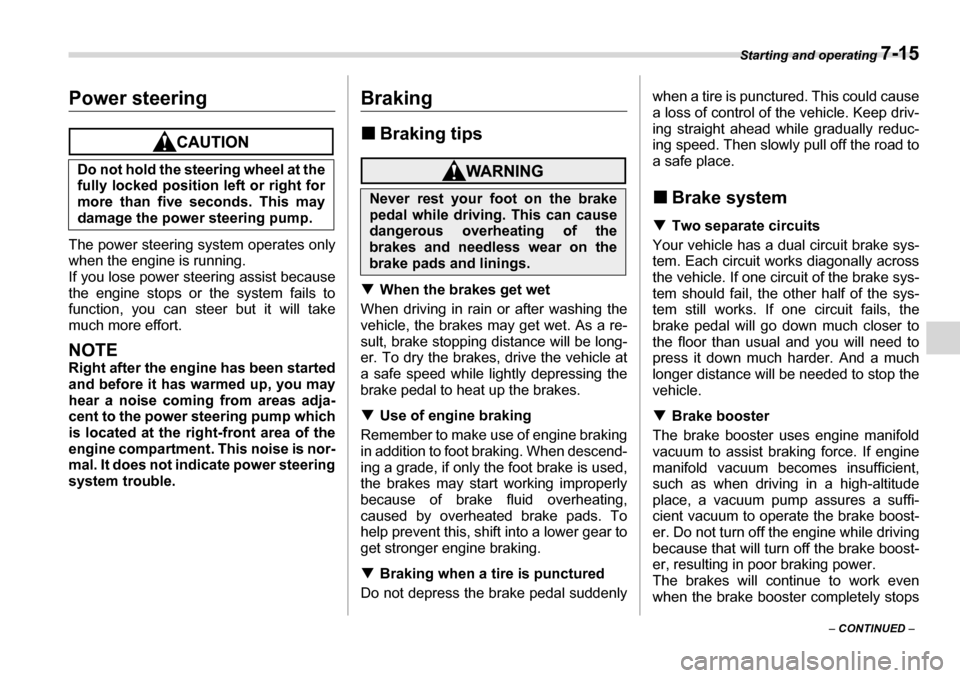
Starting and operating 7-15
– CONTINUED –
Power steering
The power steering system operates only
when the engine is running.
If you lose power steering assist because
the engine stops or the system fails to
function, you can steer but it will take
much more effort.
NOTE
Right after the engine has been started
and before it has warmed up, you may
hear a noise coming from areas adja-
cent to the power steering pump whichis located at the right-front area of the
engine compartment. This noise is nor-
mal. It does not indicate power steering
system trouble.
Braking �„Braking tips
�TWhen the brakes get wet
When driving in rain or after washing the
vehicle, the brakes may get wet. As a re-
sult, brake stopping distance will be long-
er. To dry the brakes, drive the vehicle at
a safe speed while lightly depressing the
brake pedal to heat up the brakes. �T Use of engine braking
Remember to make use of engine braking
in addition to foot braking. When descend-
ing a grade, if only the foot brake is used,
the brakes may start working improperly
because of brake fluid overheating,
caused by overheated brake pads. To
help prevent this, shift into a lower gear to
get stronger engine braking. �T Braking when a tire is punctured
Do not depress the brake pedal suddenly when a tire is punctured. This could cause
a loss of control of the vehicle. Keep driv-
ing straight ahead while gradually reduc-
ing speed. Then slowly pull off the road to
a safe place. �„
Brake system
�T Two separate circuits
Your vehicle has a dual circuit brake sys-
tem. Each circuit works diagonally across
the vehicle. If one circuit of the brake sys-
tem should fail, the other half of the sys-
tem still works. If one circuit fails, the
brake pedal will go down much closer to
the floor than usual and you will need to
press it down much harder. And a much
longer distance will be needed to stop the vehicle. �T Brake booster
The brake booster uses engine manifold
vacuum to assist braking force. If engine
manifold vacuum becomes insufficient,
such as when driving in a high-altitude
place, a vacuum pump assures a suffi-
cient vacuum to operate the brake boost-
er. Do not turn off the engine while driving
because that will turn off the brake boost-
er, resulting in poor braking power.
The brakes will continue to work even
when the brake booster completely stops
Do not hold the steering wheel at the
fully locked position left or right for
more than five seconds. This may
damage the power steering pump.
Never rest your foot on the brake
pedal while driving. This can cause
dangerous overheating of the
brakes and needless wear on the
brake pads and linings.
Page 270 of 377
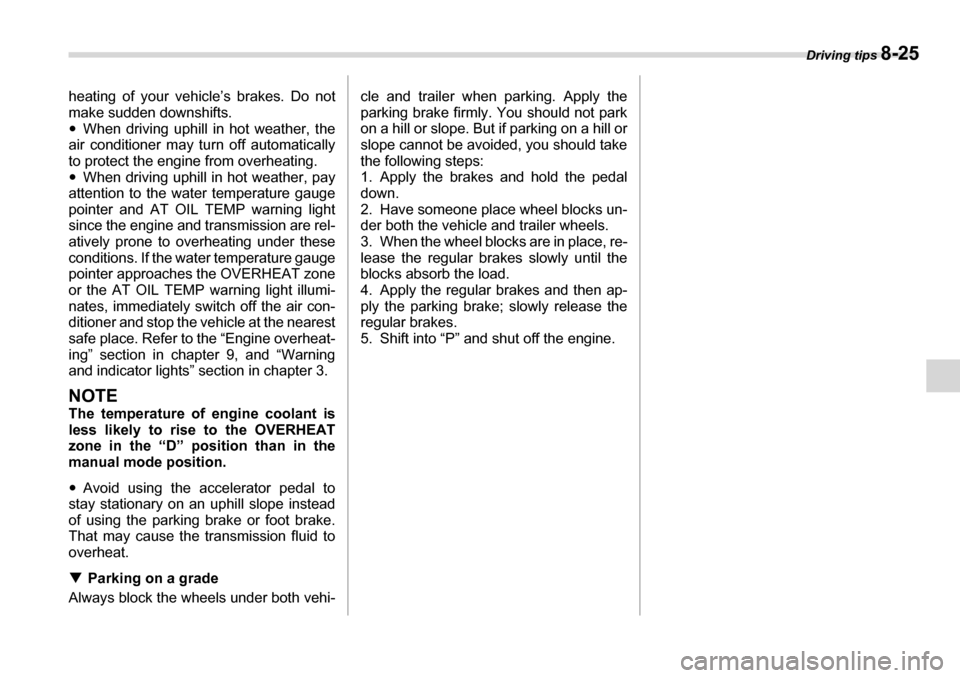
Driving tips 8-25
heating of your vehicle’s brakes. Do not
make sudden downshifts. �yWhen driving uphill in hot weather, the
air conditioner may turn off automatically
to protect the engine from overheating. �y When driving uphill in hot weather, pay
attention to the water temperature gauge
pointer and AT OIL TEMP warning light
since the engine and transmission are rel-
atively prone to overheating under these
conditions. If the water temperature gauge
pointer approaches the OVERHEAT zone
or the AT OIL TEMP warning light illumi-
nates, immediately switch off the air con-
ditioner and stop the vehicle at the nearest
safe place. Refer to the “Engine overheat-
ing” section in chapter 9, and “Warning
and indicator lights” section in chapter 3.
NOTE
The temperature of engine coolant is
less likely to rise to the OVERHEAT
zone in the “D” position than in the
manual mode position. �y Avoid using the accelerator pedal to
stay stationary on an uphill slope instead
of using the parking brake or foot brake.
That may cause the transmission fluid to
overheat. �T Parking on a grade
Always block the wheels under both vehi- cle and trailer when parking. Apply the
parking brake firmly. You should not park
on a hill or slope. But if parking on a hill or
slope cannot be avoided, you should take
the following steps:
1. Apply the brakes and hold the pedal
down.
2. Have someone place wheel blocks un-
der both the vehicle and trailer wheels.
3. When the wheel blocks are in place, re-
lease the regular brakes slowly until the
blocks absorb the load.
4. Apply the regular brakes and then ap-
ply the parking brake; slowly release the
regular brakes.
5. Shift into “P” and shut off the engine.
Page 272 of 377
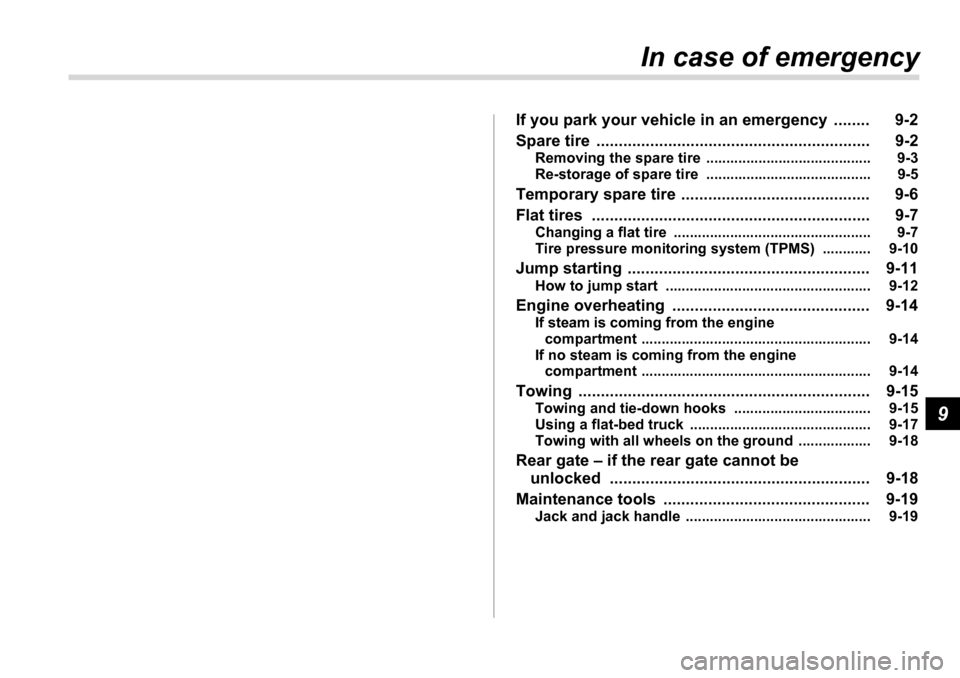
9
In case of emergency
If you park your vehicle in an emergency ........ 9-2
Spare tire ............................................................. 9-2 Removing the spare tire ......................................... 9-3
Re-storage of spare tire ......................................... 9-5
Temporary spare tire .......................................... 9-6
Flat tires .............................................................. 9-7 Changing a flat tire ................................................. 9-7
Tire pressure monitoring system (TPMS) ............ 9-10
Jump starting ...................................................... 9-11 How to jump start ................................................... 9-12
Engine overheating ............................................ 9-14 If steam is coming from the engine compartment ......................................................... 9-14
If no steam is coming from the engine
compartment ......................................................... 9-14
Towing ................................................................. 9-15 Towing and tie-down hooks .................................. 9-15
Using a flat-bed truck ............................................. 9-17
Towing with all wheels on the ground .................. 9-18
Rear gate – if the rear gate cannot be unlocked .......................................................... 9-18
Maintenance tools .............................................. 9-19 Jack and jack handle .............................................. 9-19
Page 285 of 377

9-14 In case of emergency
5. Start the engine of the vehicle with the
booster battery and run it at moderate
speed. Then start the engine of the vehi-
cle that has the discharged battery.
6. When finished, carefully disconnect the
cables in exactly the reverse order.Engine overheating
If the engine overheats, safely pull off the
road and stop the vehicle in a safe place. �„If steam is coming from the
engine compartment
Turn off the engine and get everyone
away from the vehicle until it cools down. �„ If no steam is coming from
the engine compartment
1. Keep the engine running at idling
speed.
2. Open the hood to ventilate the engine compartment.
Confirm that the cooling fan is turning. If
the fan is not turning, immediately turn off the engine and contact your authorized
dealer for repair.
3. After the engine coolant temperature
has dropped, turn off the engine.
If the temperature gauge stays at the
overheated zone, turn off the engine.
4. After the engine has fully cooled down,
check the coolant level in the reserve
tank.
If the coolant level is below the “MIN”
mark, add coolant up to the “MAX” mark.
5. If there is no coolant in the reserve
tank, add coolant to the reserve tank.
Then remove the radiator cap and fill the
radiator with coolant.
If you remove the radiator cap from a hot
radiator, first wrap a thick cloth around the
radiator cap, then turn the cap counter-
clockwise slowly without pressing down
until it stops. Release the pressure from
the radiator. After the pressure has been
fully released, remove the cap by pressing
down and turning it.
Never attempt to remove the radia-
tor cap until the engine has been
shut off and has fully cooled down.
When the engine is hot, the coolant
is under pressure. Removing the
cap while the engine is still hot
could release a spray of boiling hot
coolant, which could burn you very
seriously.
Page 370 of 377

Index 14-3
CHECK ENGINE warning light/Malfunction indicator
lamp .............................................................................. 3-12
Checking Brake pedal free play ................................................. 11-21
Brake pedal reserve distance .................................... 11-21
Engine oil level ............................................................ 11-7
Fluid level ............................................ 11-15, 11-19, 11-20
Gear oil level .............................................................. 11-17
Child restraint systems ..................................................... 1-30
Installation with seatbelt .............................................. 1-33
Lower and tether anchorages ...................................... 1-38
Child safety ............................................................................ 5
Locks ........................................................................... 2-19
Chime
Key ................................................................................ 3-4
Seatbelt ....................................................................... 1-17
Cleaning
Aluminum wheels ........................................................ 10-3
Interior ......................................................................... 10-4
Ventilator grille ............................................................. 4-10
Climate control system ....................................................... 4-5
Clock ................................................................................ 3-21
Coat hook ......................................................................... 6-10
Cooling system ............................................................... 11-10
Corrosion protection ................................................ 8-10, 10-3
Cruise control ................................................................... 7-27
Set indicator light ......................................................... 3-20
Cup holder .......................................................................... 6-6 D
Daytime running light system ........................................... 3-27
Differential gear oil Front ........................................................................... 11-16
Rear ........................................................................... 11-17
Dimensions ....................................................................... 12-2
Disarming the system ....................................................... 2-16
Disc brake pad wear warning indicators ........................... 7-16
Dome light ................................................................ 6-2, 11-44
Door locks ........................................................................... 2-4
Door open warning light .................................................... 3-17
Drive belts ....................................................................... 11-15
Driving All-Wheel Drive vehicle ................................................ 3-17
Car phone/cell phone ........................................................ 7
Drinking ............................................................................. 6
Drugs ................................................................................ 6
Foreign countries ........................................................... 8-4
Pets ................................................................................... 7
Snowy and icy roads ...................................................... 8-9
Tips ....................................................................... 7-13, 8-4
Tired or sleepy .................................................................. 7
E
Electrical system ............................................................... 12-3
Electronic Brake Force Distribution (EBD) system ........... 7-18
Emergency Locking Retractor (ELR) ................................ 1-16
Engine Compartment overview ................................................ 11-6
Coolant ....................................................................... 11-11
Exhaust gas (Carbon monoxide) ................................... 8-2
Hood ............................................................................ 11-4
Oil ................................................................................. 11-7
Overheating ................................................................. 9-14
Starting ........................................................................... 7-7
Page 372 of 377
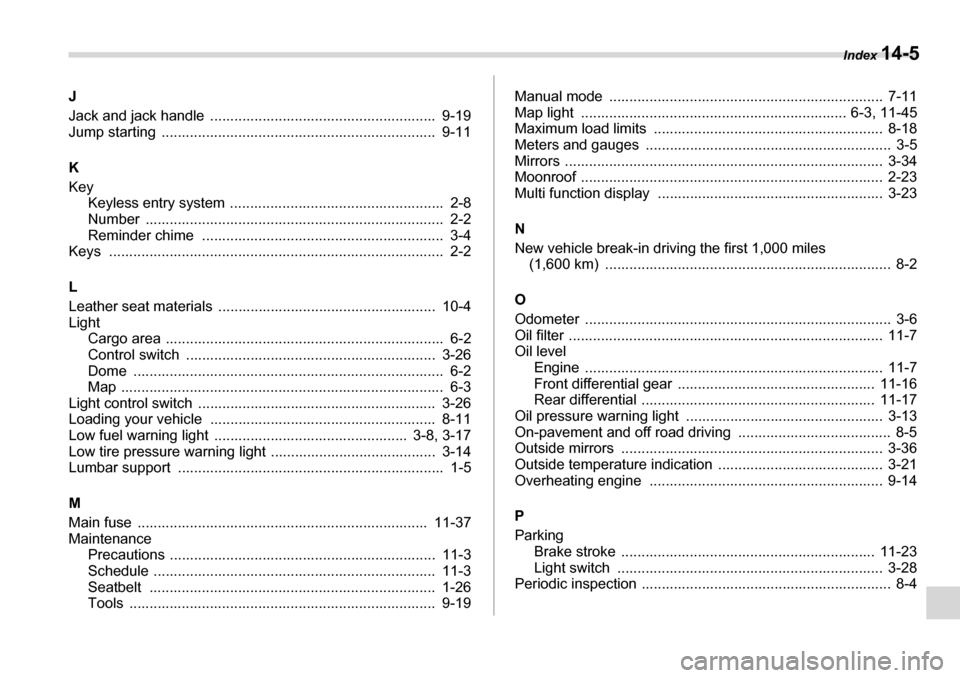
Index 14-5
J
Jack and jack handle ........................................................ 9-19
Jump starting .................................................................... 9-11 K Key
Keyless entry system ..................................................... 2-8
Number .......................................................................... 2-2
Reminder chime ............................................................ 3-4
Keys ................................................................................... 2-2 L
Leather seat materials ...................................................... 10-4
Light Cargo area ..................................................................... 6-2
Control switch .............................................................. 3-26
Dome ............................................................................. 6-2
Map ................................................................................ 6-3
Light control switch ........................................................... 3-26
Loading your vehicle ........................................................ 8-11
Low fuel warning light ................................................ 3-8, 3-17
Low tire pressure warning light ......................................... 3-14
Lumbar support .................................................................. 1-5 M
Main fuse ........................................................................ 11-37
Maintenance Precautions .................................................................. 11-3
Schedule ...................................................................... 11-3
Seatbelt ....................................................................... 1-26
Tools ............................................................................ 9-19 Manual mode .................................................................... 7-11
Map light .................................................................. 6-3, 11-45
Maximum load limits ......................................................... 8-18
Meters and gauges ............................................................. 3-5
Mirrors ............................................................................... 3-34
Moonroof ........................................................................... 2-23
Multi function display ........................................................ 3-23 N
New vehicle break-in driving the first 1,000 miles
(1,600 km) ....................................................................... 8-2
O
Odometer ............................................................................ 3-6
Oil filter .............................................................................. 11-7
Oil level Engine .......................................................................... 11-7
Front differential gear ................................................. 11-16
Rear differential .......................................................... 11-17
Oil pressure warning light ................................................. 3-13
On-pavement and off road driving ...................................... 8-5
Outside mirrors ................................................................. 3-36
Outside temperature indication ......................................... 3-21
Overheating engine .......................................................... 9-14 P Parking Brake stroke ............................................................... 11-23
Light switch .................................................................. 3-28
Periodic inspection .............................................................. 8-4